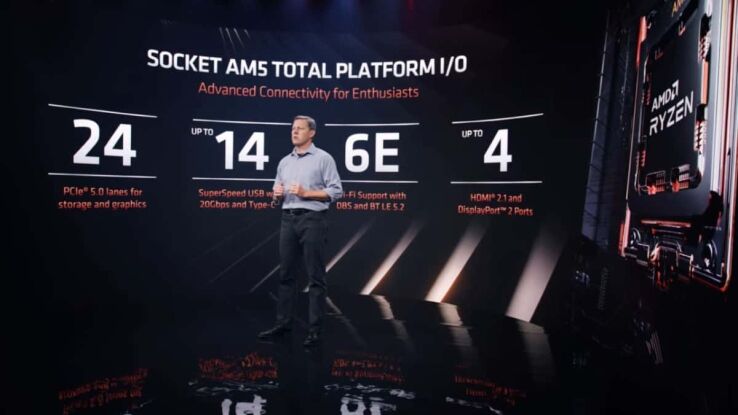AMD’s AM5 will support PCIe 5.0
Speed, I am speed

WePC is reader-supported. When you buy through links on our site, we may earn an affiliate commission. Prices subject to change. Learn more
Another key feature AMD focused on with its new AM5 platform is that it will support PCIe 5.0. As well as moving to an LGA socket the new release will move up to the next generation of interconnectivity. With the ever-increasing power of graphics cards and storage, the new standard will double the available throughput for expansions.
AMD will be the first to implement the standard and the new chipsets will have varied support for it. Currently, three different options will be available first. At the top of the range you have X670E, the extreme version, aimed at extreme overclocking will supports PCIe 5.0 everywhere. So likely to support multiple slots supporting it not just the usual one along with storage. Whereas the normal X670 only says PCIe 5.0 storage and graphics, which may suggest only one slot and storage of those speeds. Whilst the lowest B650 will only support PCIe 5.0 storage and so will continue with 4.0 graphics.
What is PCIe 5.0?
PCI Express (Peripheral Component Interconnect Express) is the standard for high-speed interconnectivity between expansion buses. These work with the slot ins or storage to allow them to communicate with the rest of the motherboard. So the PCIe standard dictates the speed these devices can talk to the rest of the devices at.
The different version of PCIe is the iteration of it and tells you how fast the throughput of it is. Starting off at 1.0 in 2003 most current motherboards and graphics cards utilize 4.0 as of the latest generation. Which on a full x16 slot allows a throughput of 31.508 GB/s so the next 5.0 update will double the available rate to 63.105 GB/s.
From the table below you can see the standard and their throughputs. You can see the adoption of the faster versions does lag behind and the current generation of cards was the first to use 4.0 when they came out in 2020. Three years after the standard came out. Now the 5.0 version is coming up to three years old so it might be future-proofing for AMD to include it in its next platform.
| Version | Introduced | Transfer rate per lane | x1 | x2 | x4 | x8 | x16 |
|---|---|---|---|---|---|---|---|
| 1.0 | 2003 | 2.5 GT/s | 0.250 GB/s | 0.500 GB/s | 1.000 GB/s | 2.000 GB/s | 4.000 GB/s |
| 2.0 | 2007 | 5.0 GT/s | 0.500 GB/s | 1.000 GB/s | 2.000 GB/s | 4.000 GB/s | 8.000 GB/s |
| 3.0 | 2010 | 8.0 GT/s | 0.985 GB/s | 1.969 GB/s | 3.938 GB/s | 7.877 GB/s | 15.754 GB/s |
| 4.0 | 2017 | 16.0 GT/s | 1.969 GB/s | 3.983 GB/s | 7.877 GB/s | 15.754 GB/s | 31.508 GB/s |
| 5.0 | 2019 | 32.0 GT/s | 3.938 GB/s | 7.877 GB/s | 15.754 GB/s | 31.508 GB/s | 63.015 GB/s |
| 6.0 | 2022 | 64.0 GT/s | 7.563 GB/s | 30.250 GB/s | 30.250 GB/s | 60.500 GB/s | 121.000 GB/s |
What cards use PCIe 5.0?
Currently, there are no cards that use the PCIe 5.0 standard. Neither graphics cards nor storage modules yet utilize the newest standard to be implemented into motherboards. However, this may be a plan of future-proofing for AMD. Since its AM4 socket lasted so long over many chipsets it might be a way to allow early adoption for future cards. It might also be a teaser of what to expect from its RDNA3 GPUs and that they might adopt the new PCIe 5.0 standard and allow for better integration with its own products.